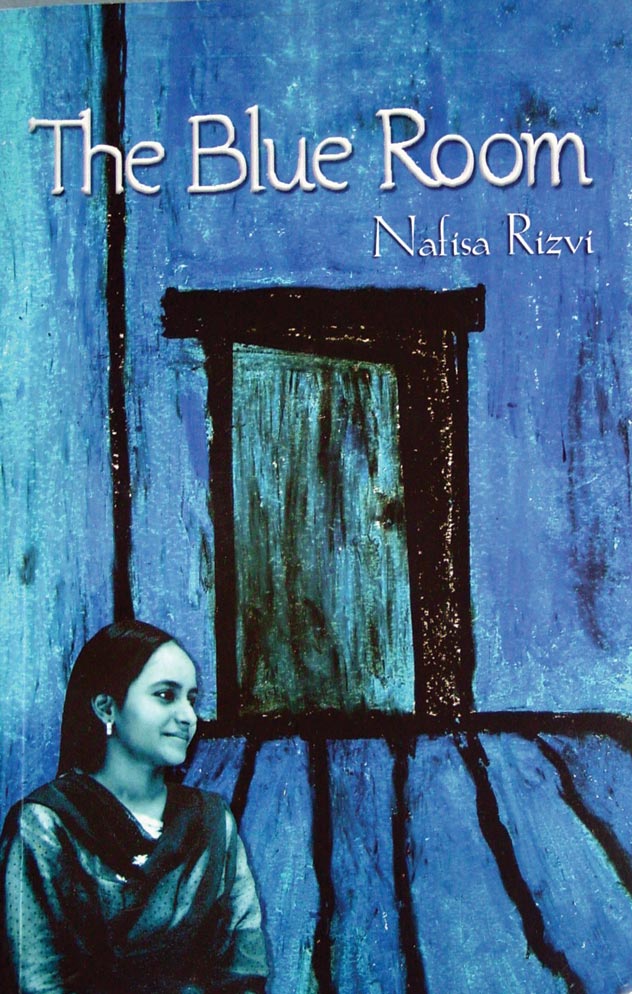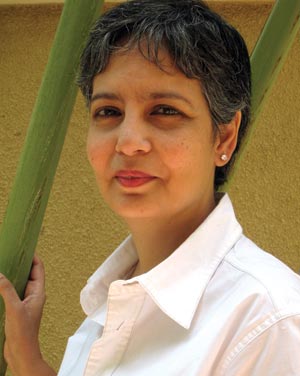FICTION
Tales of a Haveli: A Pakistani Story
The debut novel “The Blue Room” is an alluring mix of fiction and fantasy that draws a vivid portrait of a rural feudal Pakistani family’s challenges as its extended family moves to the city and has to come to terms with modernity. Ras H. Siddiqui talks to author Nafisa Rizvi.

(Above): Front cover of Nafisa Rizvi’s “The Blue Room.”
Occupying a haveli (mansion) named “Shahi Manzil” located in a remote Pakistani village is a very special feudal family which actually never sleeps. And if that itself does not initially grab the reader’s attention, the main character certainly will, a girl-child and later woman by the name Zaib who possesses magical powers and through whom we experience first time novelist Nafisa Rizvi’s captivating “The Blue Room” and its secretly talking walls.
“If you cut yourself off from your roots, you will bleed,” is a line focused on in this colorful tale of family ties and the collective anguish of a small clan from amongst the rural elite, one which eventually moves to the big city but just cannot leave behind its challenges easily. It becomes a part of an internal migration story and of escape, hope and reservations.
Grandmother, Qurut-ul Ain sums up their dilemma best when she says, “Your children will wander aimlessly on the earth not knowing where to build their homes or bury their dead. They will be unrecognizable in a sea of faces. Who will know that they belong to the family of the indomitable Sulaiman Khan? Who will care?”
Readers will find a great deal in “The Blue Room” than a migration tale. What I really enjoyed was the incorporation of the supernatural into the plot. This book stirred up enough of an interest for this writer to reach Nafisa and interview her for the benefit of our readers. After reading the book, one can convincingly write that in spite of some minor imperfections it deserves a much wider audience (in other parts of south Asia, Europe and in North America). More works of Pakistani women fiction writers in English need to be read, because some of them continue to paint surprisingly vivid, independent and colorful tales of life against some pretty strong social winds on an often unforgiving canvas. Excerpts from an interview with the author follow.
 (Right): Author Nafisa Rizvi (Right): Author Nafisa Rizvi
The Blue Room” story style and presentation had an almost Marquez-ian feel to it. Did you find inspiration from reading Gabriel García Márquez’s “One Hundred Years of Solitude” like some other south Asian writers?
Yes, of course. To me, magic realism is one of the most wonderful genres of fiction. I used to think the genre was restricted to Latin America until I began to read the Japanese writer Haruki Murakami (“Kafka on the Shore”), the Spanish writer Ruiz Zafon (“The Shadow of the Wind”), not to mention Rushdie, Marquez and of course Gunter Grass with “The Tin Drum” -- the bible of all magic realism writings. They all follow, in their own unmistakable way, the true spirit of this form of the writing, while bringing to it a color that is respectively rooted in their indigenous cultures.
I truly believe that the genre of magic realism is appropriate for our culture because we have a tendency to mix fact and fiction easily. People tell me of how they always heard their ancestors say that Jinns, some malignant and some benign, used to cohabitate with family members especially in large houses or havelis and it was reported without any degree of incredulity. I remember hearing stories of people who were seers having been given their gift because they were honest and close to God in some way
Your story is also about internal migration in Pakistan. You have lived overseas and returned but there still is a strong focus on the immigrant dilemma in your book. What is “The Blue Room” really trying to convey to the diaspora?
I realize that it may sound like a diatribe against people who have emigrated but it’s actually not. I think people leave their home under all sorts of circumstances, some difficult and painful. One must also carefully analyze reasons for leaving home and if it is only greener pastures in material terms they are looking for, they will always be unhappy and never find peace because you never leave your problems behind; you only trade one set of problems for another. But the point is to remember your roots no matter where you are. The idea in my book that people who cut themselves off from their roots will bleed is taken from a Pablo Neruda poem which says just this. People in the diaspora take it literally to mean that they must not blend in with their acquired home and must in fact stay stolidly Pakistani and rigid about dress and manner and food, though these things for me are irrelevant.
I think cultural values and the values of home and family are worth preserving no matter where you may live. It is for these values that we will be judged and respected even by the people we want so much to hate.
Your main character Zaib in the book is immensely absorbing in both a natural and super-natural way. How was the girl and later woman Zaib born in your writing moments?
You ask me as if you have written a lot of fiction and know exactly where characters come from and evolve. Zaib was born of my unfulfilled needs, my aspirations, and an internal angst but as she grew, she sort of escaped from my grasp and decided to live life by her rules and not mine. There is a conflict in her when she is doing what she knows perhaps to be wrong but does it anyway to spite herself and me. No, I am not referring to my relationship with my daughter!
“The Blue Room” is an extended family tale even though Zaib is the medium through which most of the tale is told. It is a dissection of feudal families in both their benevolent and violently sadistic forms. You seem to convey that change is inevitable for these families in Pakistan. But how fast are things really changing there?
Unfortunately, they are not. I see the children from feudal backgrounds going abroad to study and when they return, they slip into the old mould like they had never left. Some are bringing a sense of modernity with a small degree of technological advancement, setting up computerized systems for their lands, but they see the power and glory that their position affords them and relish it too much to initiate any kind of change.
I believe that feudalism has seen its day and will fall but there is a lot of resistance to it, unlike the extended family system. It is amazing how much of a knock that system has taken, proven by the number of old people’s homes mushrooming in the urban areas of Pakistan. Shifting trends with double income families, women’s education and empowerment is making these changes possible although if I am painting a rosy picture, please desist from believing me and understand that in many areas we are regressing instead of progressing and it will be our undoing.
Religious deception gets quite a prominent role in your book. Why did you feel that exposing it in Pakistani society was so important and just how prevalent is it there?
It is quite rampant. Don’t even start me on this because it raises my blood pressure considerably. The sad part is that these mullahs work on all strata of society. Not only do the fake clerics needle the poor who are completely ensnared by them and lean on them for all types of succor, both physical and mental, but they also insidiously enter rich people’s lives and have the capacity to affect men and women alike. I suppose one should not be surprised at this because we see that people with loads of money to spare are not spared unhappiness and in fact are mired in their empty lives. Religion is a great panacea for disillusionment and the doctor who gets to prescribe it becomes God.
“The Blue Room” is quite a liberal book from a Pakistani writer. Did you have difficulty finding a publisher for it within the country?
You’d be surprised at the amount of uncensored fiction in Pakistan. That’s because no one reads it! There are few amidst the 160 million-strong population of Pakistan who can read English and of those, fewer who want to read English fiction. Add to that a rather narrow minded clique of people who want a gora to tell them that their writers are good or bad. I made the critical mistake of not ensuring a foreign publisher or critic to review the book before it came out so it got little or no attention in the press. Whatever I sold was by word of mouth and the reaction was one of surprise because the readers couldn’t figure out how it was that they enjoyed the book but hadn’t heard of it in the press. Anyway, C’est la vie!
Why the color Blue for the Room?
I seriously have no idea which corner of my brain that came from! I can tell you I have an affinity for the color and so on but I don’t quite know myself.
The idea of the walls talking came from the notion that if walls have ears, they must be able to speak too. And I know from my mother’s stories that the havelis she lived in were whitewashed routinely with a hint of neel to add brightness to the walls. Put the two ideas together, add a dash of hyperbole and voila! –The Blue Room!
(The Blue Room can be acquired through http://www.samabooks.com for Rupees 525/- or $10 and though the author at nafisarizvi@gmail.com)
|